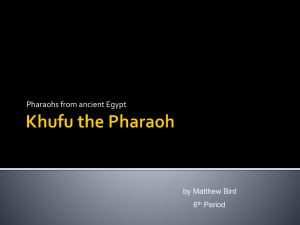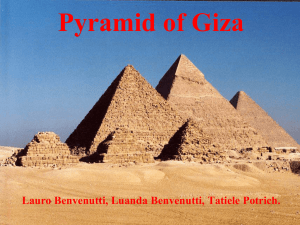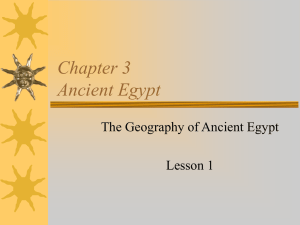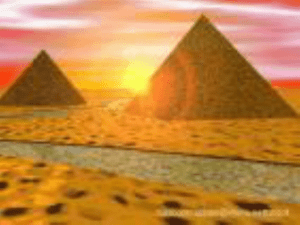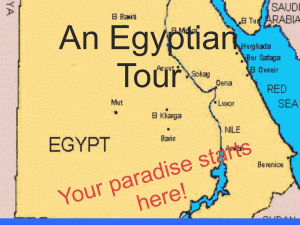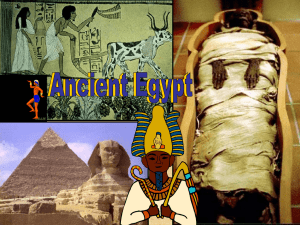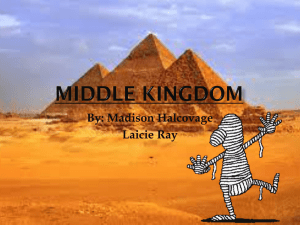Ancient Egypt: A Trip Fit For A Pharaoh!
advertisement
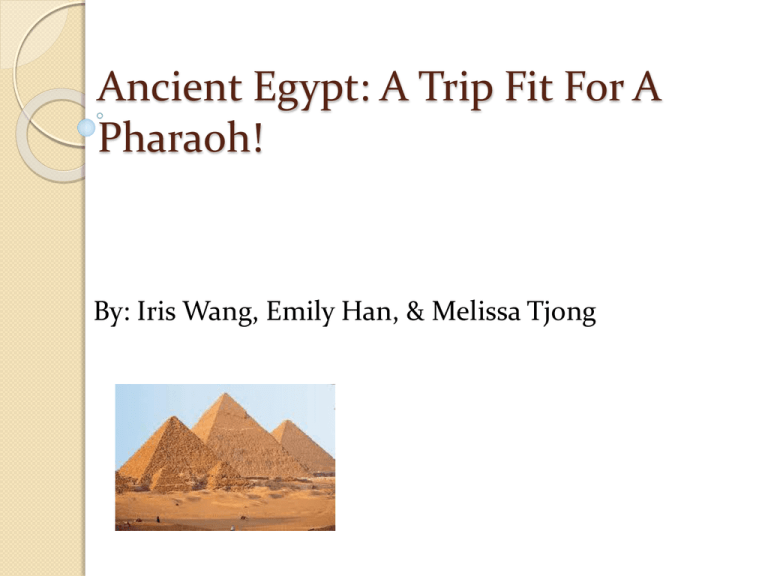
Ancient Egypt: A Trip Fit For A Pharaoh! By: Iris Wang, Emily Han, & Melissa Tjong There are so many sites to see and so many great deals! You can cruise down the Nile or visit the Great Pyramids and the Sphinx! Here is a preview of Ancient Egypt... Fun Facts About Ancient Egypt Ancient Egyptians thought it important to record information on religion and government and thus invented a type of picture writing called hieroglyphics Later on, an easier way of writing was created, called Demotic script; this was also invented by Egyptians so they were able to preserve history, beliefs, and ideas First to have a government system; the pharaoh had an organized army, a police force, and a huge number of ministers and government officials that helped him Invented a decimal system that consisted of 7 different symbols Created the idea of mummification and sending dead people to their afterlife Fun Facts (cont.) Built pyramids that pharaohs were buried in Ancient Egypt had many skilled and trained laborers who were often well-respected in their community and had a comfortable lifestyle; their social standing depended on their skill and experience Egypt’s pharaohs were the most powerful people in Egypt and thus were named “Lord of the Two Lands”; they owned all land and made laws, collected taxes, defended Egypt, and was also respected as their religious leader Today more than 70,000,000people live along the Nile’s banks Egypt’s Geography There are deserts to the east and west of the Nile River and mountains to the south This type of geography left ancient Egyptians in isolation which allowed them to develop a truly distinctive culture and a natural barrier from invaders The Nile was Egypt’s source of life; it gave fresh water for bathing and drinking, supported transportation and trade, provided materials for building, making cloths, and paper In the spring, water runs off the mountains and floods the Nile, which after the floods receded, gave them fertile soil Ancient Egyptians thought of Egypt as being divided into to lands, “the red land” and “the black land” “Red land” symbolized the red barren deserts to the east and west of the Nile “Black land” symbolized the fertile black silt along the banks of the Nile Had fertile land as well as natural resources Across the country, there were places that supplied Egyptians with copper, gold, tin, amethyst, limestone, turquoise, feldspar, granite, alabaster, quartzite, and basalt Walk Like An Egyptian: Family Life Ancient Egyptians highly valued family life Regarded children as a blessing In lower classes, mothers had to take care of their children while if a noble had children, they had slaves and servants to take care of the kids Women and girls were always expected to obey fathers and husbands although they could own land, business deals, and represent themselves in court cases Though women were of a lesser position than men, mothers and wives could be the actual ruling power of Egypt if their sons or husbands were the pharaoh Children looked after elderly parents Sons inherited land and daughters inherited household goods Jobs that women had include: maids, nannies, mourners, perfume makers, farmers, acrobats, dancers, singers, and musicians; were able to be priestesses if they were noble Most ancient Egyptians worked as field hands, farmers, craftsmen, and scribes; only a handful of people were nobles Family Life (cont.) Girls learned how to maintain the house at 4 years old; included learning to sew, cook, keep house clean, make clothes, plant fields, and prepare food They were married at 8-12 years old Boys’ learning was separated from the girls’ After 5 years, poor boys would help with men jobs in the fields and their education went from age 7-16 At 16, they could work and could marry when they were 17-20 Their lifespan was about 30 years for a poor man Households Egyptians built mudbrick homes Grew some of their own food and traded in villages for food and goods they couldn’t produce In their houses, there were clay ovens and open fires to bake, foil, stew, fry, grill, and roast Their favorite food was bread and beer made from barley They used the sun and water clocks to keep track of the time Their calendar was based on the star Sirius Was 365 days long Egyptian Style All hair was short Young girls had pigtails Young boys shaved their heads Everyone wore jewelry, earrings, armlets, bracelets, and anklets; nobles wore jeweled and beaded collars called wesekhs which were made of gold, silver, and precious stones Clothes were made of linen People mostly wore skirts Men's skirts were called kilts Games Egyptians loved games A couple were Senet, also known as Seega, and Dogs and Jackals Senet symbolized the passage of the diseased through the Underworld Dogs and Jackals had pawns with the heads of animals Religion Egyptians believed in Polytheism Anubis was God of embalming the dead Ra was the sun god He was the most important god Horus is known as the protector and ruler of the earth. Temples were the homes of gods and goddesses Egyptian Hieroglyphics Hieroglyphics is the Egyptian language, and they are drawings of familiar objects, simplified so they’re easier to draw. Made up of three types of symbols; alphabetic signs correspond to a letter or sound used by that sign. Syllabic symbols stand for sounds produced by a group of letters, a syllable. Determinative signs relate to a specific object or idea, like man, woman, or water. They can be read from left to right, right to left, or top to bottom. Hieroglyphics means “sacred drawings” in Greek. The Egyptians used them from 3000BC to 300AD. After Alexander the Great conquered Egypt, the Egyptians used the Greek alphabet. They used hieroglyphs for religious things. The Rosetta Stone A troop of French soldiers found the stone in the city of Rosetta in 1799. The Rosetta Stone was inscribed with a law made in 196BC, written in two forms of hieroglyphics and in ancient Greek. A French scholar named Jean François Champollion translated the Egyptian into Greek. Champollion also found out that hieroglyphs had originally been pictographs, but they stood for sounds in later times. This is picture shows the alphabet in hieroglyphics Egypt’s History Home to one of the most ancient and earliest civilizations History was split into 3 different time periods; Old Kingdom, Middle Kingdom, and New Kingdom Old Kingdom- this was the only time period when pharaohs were buried in pyramids Middle Kingdom- was known as the Golden Age because it was the time when trade, art, and literature flourished New Kingdom- Egypt’s expansion period and when pharaohs were buried in the Valley of the Kings Famous Landmarks Great Pyramids- a few of many amazingly built pyramids; these are 3 of the best preserved pyramids located in Giza Great Sphinx- a large human-headed lion that was carved from a mound of natural rock in Giza; it is guarding the pharaoh who built it, Khafre’s, pyramid Pyramid Theories There are many theories about how Ancient Egyptians built their pyramids. Some believed aliens helped them build the pyramids Herodotus wrote that they used “giant machines” The most likely theory is that about 100,000 people were employed. They built ramps and dragged the stones up where they set them into place The Great Pyramids of Giza They are the three most well preserved and famous pyramids Named Khufu, Khafre, and Menkaure Pyramids named after the pharaohs who built them and are buried in them Built in the 4th dynasty of Egypt Construction of the first pyramid, Khufu, started in 3200 B.C. Scientists can understand the age of the pyramids because the pottery in the pyramids look like the style of pottery from the time of Khufu, Khafre, and Menkaure Also have inscriptions inside to somewhat tell us when it was built Many unique chambers in each pyramid including: Upper Grand Galley, Lower Grand Galley, King’s chamber, Queen’s chamber, false chamber in case of burglars, and a room where all the pharaoh’s possessions were stored In front of the Great Pyramids, stands the Sphinx guarding these tombs Tombs for pharaohs and queens 80 known pyramids in Egypt At the top of the pyramid there would be a stone in the shape of a pyramid covered in gold or electrum Pyramid Khufu Also known as the Great Pyramid Construction of the first pyramid, Khufu, started in 3200 B.C. Construction was overviewed by Khufu’s brother, Hemienu Largest pyramid from three Weighs about 6 million tons More than 2,300,000 limestone and granite blocks were pushed, pulled, and dragged into place on Khufu. Average weight of each block was 2.5 tons The base of this pyramid is 230 meters or 755.9 feet on each side; covered 13 acres in all 480.6 feet tall Pyramid Khafre Second largest pyramid in Giza Stands at a staggering height of 470.5 feet The base of this pyramid is 230 meters or 755.9 feet Stands of higher ground, giving the impression that it is larger than pyramid Khufu. The entrance is 50 ft above ground level. Has 2 passages traveling into the pyramid Pyramid Menkaure Smallest pyramid from the three in Giza Built for and by Menkaure, Kafre’s son. Built in 26th century B.C. Was 65.5m tall when built; nowadays it stands 62m or 204 feet Thought to have been enlarged during building process Made of limestone and pink granite Is in the southwest outskirts of Cairo, Egypt Reasons Why You Should Visit Egypt Today Our limited price of $500 to Egypt from New York isn’t going to wait very long for you to get it!!! Buy a round trip ticket and save 10%!!! Get a brochure with a coupon for 25% off a Great Pyramids tour. Contact us at http://www.amazingairlines.webs.com or email us at amazing.airlines1@gmail.com HURRY! Bibliography Pictures lifepsychologyandalotmore.blogspot.com http://www.idstyle.com/safari/egypt/hieroglyphics-table.jpg http://profyasser.files.wordpress.com/2008/11/sphinx2.jpg http://www.britishmuseum.org/explore/highlights/highlight_objects/aes/t/the_rose tta_stone.aspx http://www.ask-aladdin.com/pyramid.htm http://freestockphotos.com/EGYPT/VultureNeck.JPG http://cache.virtualtourist.com/2812290-Nile_River_at_Aswan-Aswan.jpg Fast Facts & Geography http://www.ancientegypt.co.uk/menu.html http://egypt.mrdonn.org/index.html www.mrdowling.com/604egypt.html Daily Life http://www.ancientegypt.co.uk/menu.html http://www.msnu.edu/emuseum/prehistory/egypt/dailylife.html http://www2.sptimes.com/egypt/egyptcredit.4.2.html Bibliography (cont.) Pyramids http://www.ask-aladdin.com/pyramid.htm http://www.unmuseum.org/bldpyram.htm www.ancientegypt.co.uk/pyramids/home www.pbs.org/wgbh/nova/pyramid/explore/ Hieroglyphics http://www.mrdowling.com/604-rosettastone.html http://www.historyforkids.org/learn/egypt/literature /hieroglyphs.htm http://www.seaworld.org/fun-zone/funguides/egypt/hieroglyphics.htm
